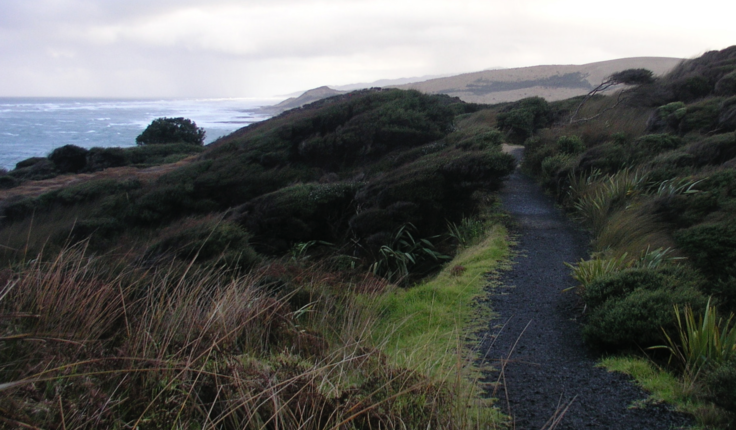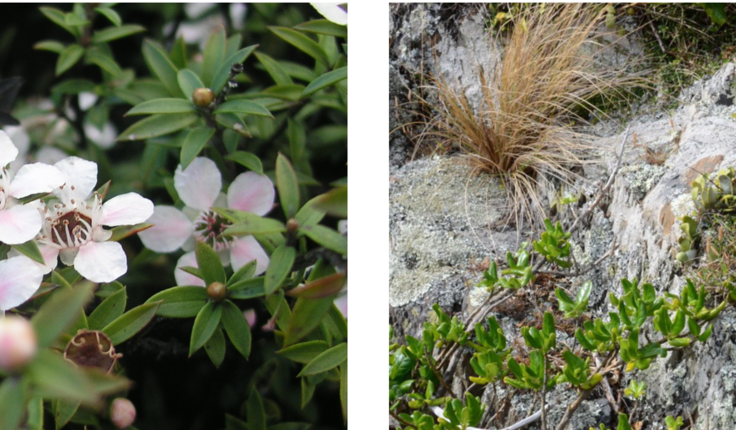News
Against the wind
Posted 24 11 2016
in Magazine

In the sixth installment of an eight-part series, plantsman David McDermott examines plants suitable for windy spots.
ONE OF THE GREATEST CHALLENGES IN PLANTING
design is being handed a ‘blank canvas’. The site may
be virtually featureless – little or no vegetation beyond pasture; no protective land forms or existing structures for design cues; soil fertility may be severely degraded, and sun and wind exposure may be extreme. The initial site plan is essentially a bare page, and it is your job to nd the inspiration (and suitable plant species) to meet your clients’ vision and needs.
Poor plant selection on an exposed site will likely mean certain death for the plants and prove costly
to the project budget -and possibly your reputation. Conversely, selecting wind-tolerant, locally-sourced species early on will give your project the best possible start, and create shelter for less hardy species to thrive as the project matures.
Proli c and adaptable species such as Phormium cookianum (mountain ax), Pittosporum crassifolium (karo) and Leptospermum scoparium (manuka) should be very familiar to most landscape practitioners - they rightly appear near the top of many exposed-site re- vegetation lists. For those searching for more botanical diversity, planting a windy site needn’t be bland - with a little research one can soon nd a plethora of tough native plants that can establish themselves on the windiest of sites.

The Acaena genus contains several hardy ground- covers that can be useful for weed-suppression and small-scale erosion control on windy sites. As always, it is worth researching your local species for best per-
formance and to support native biodiversity in your region. Acaena anserinifolia is found throughout New Zealand and forms dense copper-green mats of feath- ery foliage, and features the Velcro-like seed heads
that are a calling-card of this handy genus. Coprosma petriei is a sprawling, prostrate shrub that, like so many in the Coprosma genus, is very much at home on open ground. This tightly-tufted groundcover offers the designer a ‘moss-like’ option when a Japanese-garden aesthetic (or similar) is sought in windy conditions. Muehlenbeckia axillaris is a dense, prostrate, coastal vine that will neatly spread over rocks or walls yet will not become unruly like its larger cousin Muehlenbeckia complexa. Fine, deep-green foliage make Muehlenbeckia axillaris an excellent low ller for large gardens, while its sweetly-scented diminutive owers offer food for native copper butter ies and other nectar feeders.
Geranium traversii is a low-growing, eshy herb from the Chatham Islands with blue/silver-green leaves and white/pink owers. It is one of the few species from these islands that will thrive in cultivation on the mainland, and makes a dainty addition to windy gardens in areas of low humidity. Carex tri da is a ro- bust, broad-leaved sedge found in coastal zones which is often associated with seal haul-outs and bird-nest- ing areas; it is a reliable choice for exposed, moist landscapes. Xeronema callistemon is an unmistakable northern icon. Once found only on the windswept Poor Knight’s Islands and Hen Island near Whangarei, its bright green swords and distinctive red ower spikes
make it a superb choice for rock gardens or pots in frost-free regions.
Among the choice of native shrubs, the Brachyglot- tis genus offers several species adept at thriving on exposed sites. Brachyglottis monroi is a particularly attractive shrub with serrated grey leaves and bright yellow owers; it is endemic to the Marlborough region, making it a ne choice for drier areas of NZ. Carmichaelia glabrescens is another southeast dweller and is one of the more unusual, yet striking, species on this plant list. It is a small, lea ess tree from the broom family which bears masses of spectacular pink owers – a showy species for a steep, free draining bank, cliff face or rock wall.
Plagianthus divaricatus is a bushy shrub with tangled branches and a purple-red silhouette. It is usually found growing along open estuarine edges - it is a hardy yet elegant shrub for an exposed garden. Olearia angulata is one of many in the Olearia genus that are useful starters on windy sites. Its silver-green foliage, compact form and bright yellow owers make this small tree a wise choice as a single specimen or hedging plant in northern areas. Establishing a gar- den on an exposed site can prove a massive challenge for all involved. Fortunately, local plant species can bring an astounding range of form and colour to even the most tempestuous locations. With thorough site analysis, carefully considered plant selection and a healthy dose of patience, tackling a ‘blank canvas’ can be hugely rewarding for both designer and client.
Share
19 Dec
Christmas break 2025

see you from 12 January
As we wrap up another big year, we’re taking a moment to pause, breathe, and enjoy a well-earned break. Meri …
18 Dec
President’s update

December 2025
Earlier this month I attended the Ngā Aho Māori Design Professionals Wānanga-ā-Tau at Te Aranga Marae in Flaxmere. Tuia Pito …
18 Dec
Awards 2026 update

An update as we warm up for the 2026 Awards kaupapa. Submissions will open in March and will run for …
Events calendar
Full 2025 calendar